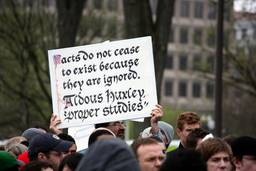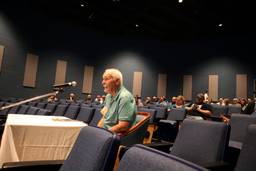
Even as experts hail the economic recovery underway, new research shows that American workers are stuck with flat or declining wages even as their productivity soars. (Hat tip to the AFL-CIO Now Blog.) What’s going on here?
As The Los Angeles Times reported this week:
Workers… are fueling a surge of productivity in the U.S. economy. Employee output per hour jumped 8.1% in the third quarter this year, the largest gain since the third quarter of 2003.
But these bustling laborers are also a big reason why companies won’t be rushing to hire new staffers any time soon. The brutal downturn has forced firms across the economy to do more with fewer hands; many have found they can manage just fine for the time being.
And, not-so-surprisingly, employers in this “buyer’s market” for employees are also taking advantage of workers’ fears of losing their jobs to work them harder without paying them more. The economics of day laborers and sharecroppers has now been extended into mainstream workplaces. The bosses’ essential message: “Take it or leave It, Buster. There are plenty of people out there eager to get your job.”
As the Los Angeles Times reported:
The nation’s unemployed aren’t the only ones struggling in a sluggish economy. For those still on the job, life is no picnic either.
Many U.S. workers are being pushed to toil harder and shoulder the load once carried by colleagues who’ve since been laid off. That can mean long days without overtime pay or raises, less family time, and more mental and physical fatigue.
Don’t like it? Walk out the door and you’ll join 15 million unemployed Americans, the largest segment of whom have been idle for more than three months. Your former boss will have plenty of replacements to choose from. There are about six job seekers for every opening.
The workload for many survivors is likely to mount in coming months. As business cycles accelerate, companies get busier, but employers are typically reluctant to add staff until they’re convinced the good times will last.
“In a recession, the employees that are left find there are demands placed upon them to work more efficiently, work harder and work more hours,” said Ross DeVol, director of regional economics at the Milken Institute.
But as the AFL-CIO Now blog points out, drawing on the Los Angeles Time article:
“According to Thomas A. Kochan, a professor of management at MIT’s Sloan School of Management, productivity gains are troubling because so far,
they haven’t been accompanied by wage increases….The threat of outsourcing has also made employees more reluctant to press for higher wages, he said, when they know that if they push too hard, their jobs could disappear.
“The result?”
Anxiety is rippling across the workplace. A survey by CareerBuilder released last month indicated that a quarter of employers rated their employees’ morale as low. Nearly half of employees said their workload had increased in the last six months, and 40% said their stress level at work was high. About one in five workers surveyed were dissatisfied with their work-life balance.
This is part of a longstanding trend in American work life, where increased productivity bears little relation to wage growth, even during the increasing prosperity and recovery before the stock market crashed in 2008. As the Economic Policy Institute reported recently:
While the past 35 years have been marked by generally strong growth in productivity, most working people have not seen comparable gains in their wages and benefits. Essentially, they are being denied a fair share of the growth that they helped create.
Unemployment is rising, and wages, depending on how they are measured, are growing very modestly or not at all. Both metrics are key measures of living standards and overall economic vitality that underscore how prosperity is eluding growing numbers of Americans. The current recession has added to the ranks of the jobless and the underemployed, but longer term trends show how wage growth for large parts of the population has stagnated even during periods of economic expansion.
In June of 2009, unemployment reached a 26-year high of 9.5%. Wages, which had held up fairly well at the start of the recession, have started to implode. In the second quarter of 2009, nominal hourly wages of production workers grew at a 0.7% annualized rate, which is only one-sixth of the 3.9% growth rate from December 2007 to December 2008. The collapse in wage growth indicates that even those who have held onto their jobs have been hurt by the recession, and threatens to dampen consumption and limit the pace of an economic recovery.
Unions, economists and labor advocates say, are essential to preserving and promoting wage growth in a tough but growing economy. As Dr. Paula Voos, a labor relations professor at Rutgers and Economic Policy Institute research associate, testified earlier this year:
Some may be concerned with the economic consequences of increased unionization at this moment in time. They should be assured that the economic consequences would be positive. There are two main reasons:
- First, greater union membership would help the United States recover from the current economic downturn and help prevent future economic crises.
- And second, greater union membership would help the United States make the transition to competing internationally on the basis of high productivity, high quality, and innovation, rather than on the basis of low wage labor or long hours - a race to the bottom that we can never win against nations like China.
Greater consumer demand from decently paid workers is just one economic benefit of unions, she pointed out.
But mounting fears among workers about losing their jobs – and given the untrammeled corporate power to break labor laws without fear of punishment – have created a difficult organzing environment for unions.
As the Los Angeles Times reported:
“There’s the phenomenon of people literally working harder, because they’re fearful of losing their jobs,” said Nelson Lichtenstein, an economist and director of the Center for the Study of Work, Labor and Democracy at UC Santa Barbara. “Rumors of layoffs are flying, so everyone works really hard.”
That can have lasting effects, he said, especially among the ranks of nonunion professionals. As they begin to work longer hours for the same pay, informal norms are created, Lichtenstein said, and they become accustomed to working 10- or 12-hour days in place of eight-hour shifts.
Such workers would seem likely to welcome approaches from unions to gain bargaining power with their employers. In fact, he said, it’s just the opposite. Wage and benefit rollbacks are common during recessions. This year General Motors and Chrysler, for example, were able to renegotiate many of their union obligations after they toppled into bankruptcy.
“It makes it more difficult for unions to organize because people are grateful to have any job,” Lichtenstein said.
Indeed, the way things are headed for blue-collar and white-collar workers alike, we’ll all be singing a version of Tennessee Ernie Ford’s “Sixteen Tons.” We’ll find ourselves another year older and deeper in debt —and owing our souls to the company store:






